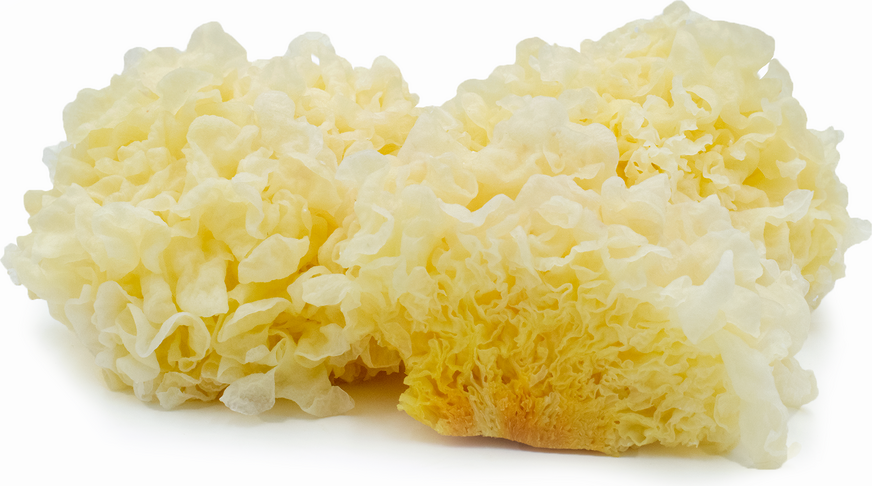


Tremella Mushrooms
Estimated Inventory, 12 ct : 0
Description/Taste
Tremella mushrooms are small to medium in size, averaging 5-7 centimeters in diameter, and are thin, ruffled, and made up of branching fronds that are attached to a central base. The fruiting body is white, pale yellow, or tan and is semi-translucent with a smooth, shiny, and gelatinous texture. When young, the mushroom is soft when moist and with age, they begin to shrink and become leathery. Tremella mushrooms have a spicy odor that dissipates with cooking and is chewy and supple with a very mild flavor.
Seasons/Availability
Tremella mushrooms are available year-round.
Current Facts
Tremella mushrooms, botanically classified as Tremella fuciformis, are a wild, edible fungus that belongs to the Tremellaceae family. Also known as the Silver Ear mushroom, White Jelly fungus, White fungus, Snow fungus, and White Tree fungus, Tremella mushrooms grow in tropical climates on damp, dead or dying hardwood of broadleaf trees and are in China for their medicinal properties. Found in fresh, dried, and canned form, Tremella mushrooms are used to add texture to a wide variety of culinary applications.
Nutritional Value
Tremella mushrooms are an excellent source of fiber and vitamin D, and also contain antioxidants, vitamins B1, B2, and B6, folate, zinc, potassium calcium, magnesium, iron, and copper.
Applications
Tremella mushrooms are best suited for cooked applications such as boiling, pan-frying, and sautéing. Before cooking, the mushrooms should be trimmed of any hard, yellow parts on the underside of the fungus and are then cut into pieces and boiled along with other flavor enhancing ingredients. One of the most common ways to prepare the mushroom is to turn it into a simple, soup-like dessert known as luk mei. Served hot or cold, this soup is served in rock candy syrup and is combined with dried longans and jujubes, often made during special occasions such as Chinese New Year and at weddings. Tremella mushrooms are also used in salads, mixed into stir-fries at the end of preparations to keep them from falling apart, and used as a thickener in soups and sauces. Tremella mushrooms pair well with green onion, cilantro, poultry, celery, carrots, dates, soy sauce, blueberries, kiwi, and vanilla ice cream. To retain their jelly-like texture, store Tremella mushrooms in the refrigerator, wrapped in paper towels, where they will last for 1-2 days. Tremella mushrooms are most often found dried, and when soaked and rehydrated, they return to almost the same texture and consistency as the fresh mushroom. Dried Tremella mushrooms will last for several months when stored in the freezer.
Ethnic/Cultural Info
In China, an imperial concubine Yang Guifei, who lived from 719 to 756 BCE, was said to be the most beautiful woman in Chinese history. Legend has it that when asked what her secret to beauty was, she replied the Tremella mushroom. Today Tremella mushrooms are still used as a beauty product by women in China and Japan, and it is claimed that if eaten, the mushrooms will contribute to a long and unblemished life. Tremella mushrooms contain an enzyme that improves moisture retention in the skin which can sometimes help with the reduction of wrinkles. In traditional Chinese medicine, Tremella mushrooms have also been used for over two thousand years to help reduce symptoms of cough-related conditions, from asthma to dry coughs, are said to nourish the kidneys, lungs, and stomach.
Geography/History
Tremella mushrooms are native to subtropical and tropical regions around the world including Brazil, Taiwan, China, Japan, and in other Asian countries. Cultivation of these mushrooms began around 1914 in China, and new cultivation techniques began in 1968, leading to the mass production of this variety and ability to export the mushroom in dried form worldwide. Today Tremella mushrooms are found fresh at local markets or in dried form in Asia, Southeast Asia, South America, Central America, Australia, New Zealand, Africa, and North America.
Recipe Ideas
Recipes that include Tremella Mushrooms. One
Podcast




